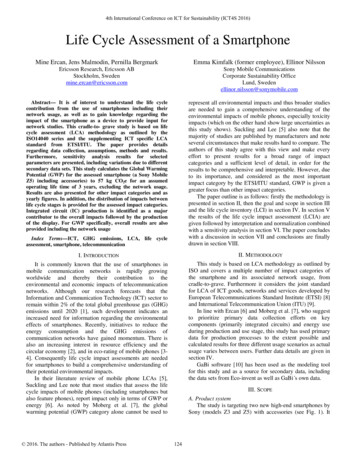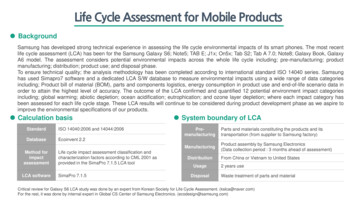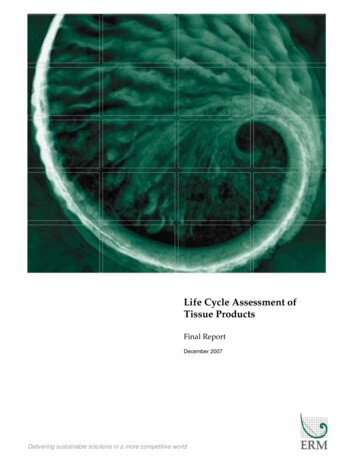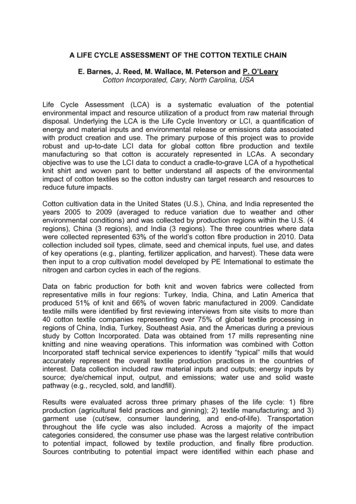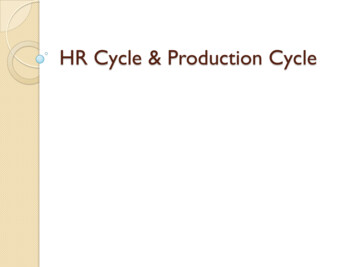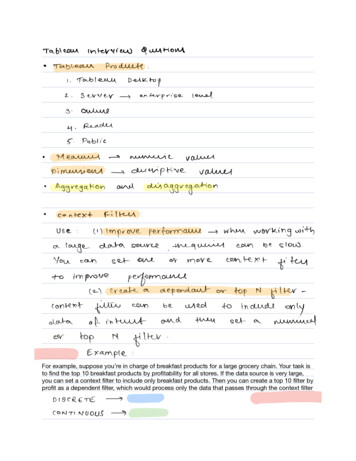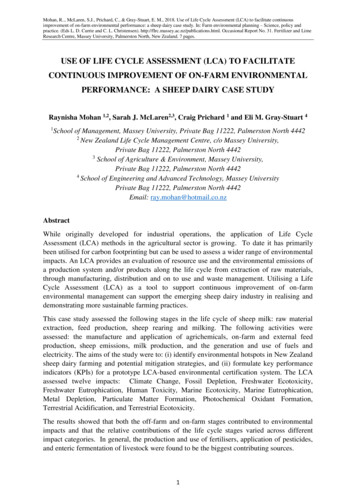
Transcription
Mohan, R., McLaren, S.J., Prichard, C., & Gray-Stuart, E. M., 2018. Use of Life Cycle Assessment (LCA) to facilitate continuousimprovement of on-farm environmental performance: a sheep dairy case study. In: Farm environmental planning – Science, policy andpractice. (Eds L. D. Currie and C. L. Christensen). http://flrc.massey.ac.nz/publications.html. Occasional Report No. 31. Fertilizer and LimeResearch Centre, Massey University, Palmerston North, New Zealand. 7 pages.USE OF LIFE CYCLE ASSESSMENT (LCA) TO FACILITATECONTINUOUS IMPROVEMENT OF ON-FARM ENVIRONMENTALPERFORMANCE: A SHEEP DAIRY CASE STUDYRaynisha Mohan 1,2, Sarah J. McLaren2,3, Craig Prichard 1 and Eli M. Gray-Stuart 41School of Management, Massey University, Private Bag 11222, Palmerston North 44422New Zealand Life Cycle Management Centre, c/o Massey University,Private Bag 11222, Palmerston North 44423School of Agriculture & Environment, Massey University,Private Bag 11222, Palmerston North 44424School of Engineering and Advanced Technology, Massey UniversityPrivate Bag 11222, Palmerston North 4442Email: ray.mohan@hotmail.co.nzAbstractWhile originally developed for industrial operations, the application of Life CycleAssessment (LCA) methods in the agricultural sector is growing. To date it has primarilybeen utilised for carbon footprinting but can be used to assess a wider range of environmentalimpacts. An LCA provides an evaluation of resource use and the environmental emissions ofa production system and/or products along the life cycle from extraction of raw materials,through manufacturing, distribution and on to use and waste management. Utilising a LifeCycle Assessment (LCA) as a tool to support continuous improvement of on-farmenvironmental management can support the emerging sheep dairy industry in realising anddemonstrating more sustainable farming practices.This case study assessed the following stages in the life cycle of sheep milk: raw materialextraction, feed production, sheep rearing and milking. The following activities wereassessed: the manufacture and application of agrichemicals, on-farm and external feedproduction, sheep emissions, milk production, and the generation and use of fuels andelectricity. The aims of the study were to: (i) identify environmental hotspots in New Zealandsheep dairy farming and potential mitigation strategies, and (ii) formulate key performanceindicators (KPIs) for a prototype LCA-based environmental certification system. The LCAassessed twelve impacts: Climate Change, Fossil Depletion, Freshwater Ecotoxicity,Freshwater Eutrophication, Human Toxicity, Marine Ecotoxicity, Marine Eutrophication,Metal Depletion, Particulate Matter Formation, Photochemical Oxidant Formation,Terrestrial Acidification, and Terrestrial Ecotoxicity.The results showed that both the off-farm and on-farm stages contributed to environmentalimpacts and that the relative contributions of the life cycle stages varied across differentimpact categories. In general, the production and use of fertilisers, application of pesticides,and enteric fermentation of livestock were found to be the biggest contributing sources.1
IntroductionNew Zealand has an established reputation as one of the world’s key dairy producers and thecountry’s sheep dairy industry has seen rapid growth with four producers in 2014 growing to16 producers in 2018 following the initial commercial start-up phase in the late 1990s. Theimportance of sustainability within the sector is demonstrated with New Zealand governmentresearch entities conducting studies on characterizing dairy sheep effluent and nitrogen (N)losses as part of their research programme ‘Boosting exports of the emerging NZ dairy sheepindustry’ (Ministry for Primary Industries, 2017).Utilising a Life Cycle Assessment (LCA) as a tool to support continuous improvement of onfarm environmental management can help the emerging sheep dairy industry with ensuringthe sustainability of their farming practices. A LCA provides an evaluation of resource useand the environmental emissions of a production system or products. It consists of thefollowing four key stages: definition of goal and scope; inventory analysis; impactassessment; and the production of recommendations for decision making (Guinée, 2002). Forthe purposes of determining the environmental impacts of sheep dairy farming practices, theLCA was conducted with a cradle-to-farmgate approach on the activities. This paper presentsthe key findings of the LCA, and identifies the environmental hotspot areas by providing ananalysis of the impact categories, accompanied with recommendations for improvements asderived from the analysis.Environmental certification systemsThe conscious consumer is a growing phenomenon worldwide. Greater access to informationas well as exposure has provided people with the knowledge of environmental and ethicalissues as well as the ways in which our daily activities contribute to these issues. Whilemarket competition has traditionally been one of economics, the conscious consumer isshifting their focus from food prices to the process by which food is produced (Schau andFet, 2008). Loureiro, McCluskey and Mittelhammer (2001) link this to the driving forcebehind the food industry’s decision to introduce certification systems and eco-labels in bothdomestic and international food markets. This growing awareness is demonstrated withsystems analysis such as LCA, a tool for producers to determine the environmental impactand resource use of their overall processing system including the impacts that come from theproduction and disposal of their products (Schau and Fet, 2008).Overview of life cycle assessmentLCA is defined by the International Organisation of Standardisation (ISO) ISO14044 to be a“compilation and evaluation of the inputs, outputs and the potential environmental impacts ofa product system throughout its life cycle” (Guinée, 2002). A LCA analysis covers the rawmaterial acquisition, production, use and disposal stages of a product.This study is in many ways exploratory. While there have been several studies conducted insheep and beef farming, as well as bovine and goat dairy farming, the majority of thesestudies in New Zealand have focussed on greenhouse gas emissions. However, a full LCAstudy covering a broader range of environmental impacts has yet to be applied to thesefarming industries.2
All efforts were made to follow the methodological framework provided by the ISO 14044which provides guidelines for quantifying material and energy inputs to determineconsequent emissions produced during the lifecycle of a product (ISO, 2006). The LCA wasconducted with the ReCiPe 2008 model, developed in 2008 by RIVM and RadboudUniversity, Centrum voor Milieukunde (CML), and PRé Consultants (Goedkoop et al., 2009).Functional unitThe functional unit for this study is 1 hectare of land used on a sheep dairy farm -abbreviatedto ha/yr. This is chosen on the basis that it is a commonly selected functional unit foragricultural LCA studies and it provides better opportunities for comparison with otherfarming scenarios and the impacts associated with the farming practices and inputs.System boundariesThe system boundary of the LCA includes the major material and energy flows associatedwith the year-round maintenance of the sheep dairy farm including manufacture andapplication of agrichemicals (fertiliser, pesticides and herbicides), pasture and supplementaryfeed production, sheep emissions, and the production and use of fuels and electricity on-farm.Nutrient losses from fertiliser applications were calculated via OVERSEER . Contractorfuels and veterinary chemicals were excluded (see Figure 1).Figure 1: System boundary of dairy sheep case-study LCA3
Key findings from impact assessmentThe following impact categories were utilised in the LCA impact assessment: Climatechange, Fossil depletion, freshwater ecotoxicity, Freshwater eutrophication, Human toxicity,Marine ecotoxicity, Marine eutrophication, Metal depletion, Particulate matter formation,Photochemical oxidant formation, Terrestrial acidification and Terrestrial ecotoxicity. Theseimpact categories were selected on the basis that they cover all the relevant environmentalissues associated with dairy farming systems.Impact assessment results were calculated using the characterisation factors in the ReCiPe(H/H) Europe 2000 (excluding biogenic carbon) Normalisation Dataset. For the purposes ofthis analysis, perspective H has been utilised as it is based on the assumptions and choicesaligned with most common policy principles with regards to timeframe and other issues(Goedkoop et al., 2009).Normalised results (eq/person/year)Results have been expressed in the same unit (eq/person/year) for each impact score therebymaking it easier to determine the relative significance of each impact category and makecomparisons between the impact scores of different impact categories (Norris, 2001). Figure2 below shows the normalised results for the different impact categories, a logarithmic scaleis used to offer a clear comparison of the 0.590.080.0030.001Normalised impact categoriesFigure 2:Normalised results for impact categories to demonstrate relative significance45.08
Identifying the environmental hotspotsTerrestrial ecotoxicity was found to pose the largest environmental impact in the LCA studyfrom the cradle- to-milking parlour gate of the dairy sheep case-study farm, followed byfreshwater ecotoxicity (see figure 2). Pesticide use was the largest contributor to theterrestrial ecotoxicity impact category, with 75% (3.82 eq/person/year) of the total impactfrom that category resulting from the releases of atrazine. Similarly, in the supplementarybarley grain production, pesticide use was the biggest contributor (see figure 3).Normalised(eq/person/yr)543210Pesticide UseBarley GrainOtherContribution of stages to Terrestrial EcotoxictyFigure 3 Contribution of sheep dairy farming stages to terrestrial ecotoxicitySensitivity AnalysisFollowing the impact assessment findings, sensitivity analyses were conducted. Alternativepesticide use on-farm was modelled utilising simazine – this found a 60% decrease interrestrial ecotoxicity and 48% decrease in freshwater ecotoxicity. Maize grain was modelledas a supplementary feed – this resulted in a 7% decrease in the terrestrial ecotoxicity and 10%decrease in freshwater ecotoxicity. In both alternative scenarios, terrestrial ecotoxicity stillposed the largest relative environmental impact in the LCA study.Development of key performance indicator (KPI) framework for certification schemeThe first stage of the development process involved determining means-based KPIs using theresults of the LCA study. Utilising the framework proposed by Lebacq et. al (2013), fourKPIs were designed for each of the respective categories: land management, nutrient use,pesticide use, energy and climate, and water quality. This involved determining the scopeand breadth of the KPIs within the respective environmental certification schemes: OriginGreen – Dairy (Bord Bia, Ireland), LEAF Marque (UK), Unilever Sustainable AgricultureCode, and Sustainably Grown Certified (US). The framework has been designed toaccompany a farm environmental plan (FEP) and a LCA of the farm.FundamentalKPISbasedonLCAresultsThe fundamental KPI for each respective category in the proposed framework is listed below.With the terrestrial and freshwater ecotoxicity being the highest impact categories in the LCAstudy, the importance of the appropriate management of land and soil resources, as well assustainable nutrient use is highlighted.LandmanagementPreparation of a farm-scale soil map stating the different soil types present and the5
identification of areas prone to compaction, erosion, runoff and leaching. This KPI has beenincluded by Origin Green; Unilever; LEAF.NutrientuseCompleting a nutrient budget and regular testing of soil fertility and crop nutrient levels, so toavoid nutrient overloading. This KPI has been included by Sustainably Grown; Origin Green;Unilever; LEAF.Pesticide useConducting a pesticide drift risk assessment with mitigation strategies undertaken tominimize potential drift.EnergyandclimateRecalculating carbon footprint with livestock changes as stocking rate and type of livestockreared can greatly impact the overall carbon footprint of the case-study. This KPI has beenincluded by Unilever.WaterqualityAll potential wastewater sources and contaminant points must be identified. Agricultural andrelated operational wastewater streams must be treated appropriately. This KPI has beenincluded by Sustainably Grown; Unilever; LEAF.DiscussionWithin the cradle-to-farmgate system boundary used in the study, the application ofpesticides and the subsequent releases to soil and water resulted in the terrestrial andfreshwater ecotoxicity being the highest and second highest impact categories respectively,following normalisation. These were subsequently identified in the KPI framework as beingan area of importance, with the inclusion of an indicator requiring a risk assessment to beconducted to determine the potential risk of pesticide risk when utilising pesticides andsimilar agrichemicals.Another hotspot area which demonstrates the importance of utilising a comprehensive lifecycle viewpoint is the utilisation of externally grown supplementary feed. The analysishighlights the sensitivity of the environmental impact in relation to the varying productioninputs required in the cultivation of supplementary feed sources. The results of the sheepdairy case study showcase the potential of LCAs in achieving sustainable milk production viaan LCA-based certification scheme which incorporates means-based KPIs derived from theLCIA results, as seen in the prototype framework developed.ConclusionThe aim of this research is to help develop the understanding of the environmentalperformance of sheep dairy farming and identify potential opportunities for improvement. Asthe first study of its kind, further research is needed to validate and confirm the findingsstated in this study. Thus, LCA results from the sheep dairy case-study are not intended to berepresentative of the entire New Zealand sheep dairy industry.6
ReferencesBaumann, H., & Tillman, A. M. (2004). The Hitch Hiker's Guide to LCA: An orientation inlife cycle assessment methodology and application: Studentlitteratur AB, Lund, Sweden.Goedkoop, M., Heijungs, R., Huijbregts, M., De Schryver, A., Struijs, J., & Van Zelm, R.(2009). ReCiPe 2008. A life cycle impact assessment method which comprises harmonisedcategory indicators at the midpoint and the endpoint level, 1.Guinée, J. B. (2002). Handbook on life cycle assessment operational guide to the ISOstandards. The international journal of life cycle assessment, 7(5), 311-313.Loureiro, M. L., McCluskey, J. J., & Mittelhammer, R. C. (2001). Assessing consumerpreferences for organic, eco-labeled, and regular apples. Journal of agricultural andresource economics, 404-416.Ministry for Primary Industries (2017) Primary Growth Partnership: Sheep - Horizon Three.Retrieved from rogrammes/sheep-horizon-three/ (accessedNovember 2017)Norris, G. (2001). The requirement for congruence in normalization. The InternationalJournal of Life Cycle Assessment, 6(2), 85-88.Schau, E., & Fet, A. (2008). LCA studies of food products as background for environmentalproduct declarations. The International Journal of Life Cycle Assessment, 13(3), 255-264.7
Green – Dairy (Bord Bia, Ireland), LEAF Marque (UK), Unilever Sustainable Agriculture Code, and Sustainably Grown Certified (US). The framework has been designed to accompany a farm environmental plan (FEP) and a LCA of the farm. Fundamental KPIS based on LCA results The fundamental KPI f

